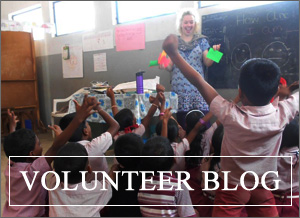We have just completed a successful week of training with our volunteers who are going overseas this summer, as part of the workshop we ask volunteers to think about teaching and planning lessons. We had some great suggestions from different people throughout the week that we thought it would be nice to share, check them out below!
Crowns
Laura-Louise suggested using a crown as a visual way of recognising good behaviour in a lesson. You can easily create your own crown from card and stickers when you’re in Thailand/India. You might want to have a few, so that if several people in your lesson are well behaved then they can all wear them. You could either collect them back at the end of the lesson, or allow them to take them home for the evening (let the teachers know you’re doing this, this will help ensure it comes back the following day!).
 Jar of marbles
Jar of marbles
This idea was suggested by Andie who uses this in her classroom at the moment as a trainee teacher. The idea is to have two jars, one that is full of marbles and one that’s empty. Throughout the lesson, every time a student demonstrates good behaviour or good team work, a marble gets moved from one jar into the other. The aim is for the students to work together as a class to move all the marbles from one jar into another, if they do this in the lesson they get a reward like 10 minutes golden time or additional time for a game at the end of the lesson.
Don’t have room for two jars and marbles in your suitcase? You can improvise in country, you might just use two water bottles and cut off the tops and then use sweets to move between the two containers. There are lots of different materials you could use to have the same affect!
Heads down thumbs up
This games was suggested by Amber who remembered playing it when she was at school as a reward for when the whole class behaved well. There was a bit of a discussion about exactly how the game is played, however the gist is that a couple of students (depending on class size) are picked to stand at the front, while the rest of the class put their heads down on the desk with their thumbs up. The students who are standing then tip toe around the class to tap peoples thumbs, once this is done they go back to the front of the class. The students whose thumbs were tapped then stand up and have to guess which student tapped their thumbs, if they get it right then they can switch places.
How to use it in the classroom: this was discussed as being a reward for good behaviour at the end of the lesson, if students behave well they get to play the game. The people who are chosen to stand at the front, could be the best behaved students or students that tried the hardest in that lesson. Encouraging the students to speak in full sentences will help to improve English too; ‘I think ___ tapped by thumbs’, ‘Yes that’s right’, ‘No, it wasn’t me’ etc.
Duck, duck, goose
This is the game where you get everyone sitting in a circle and one person is the ‘goose’, they walk around the outside of the circle. They then label each person a duck, until they decide to name one person a goose. When they do this the two geese race each other back to the vacant seat, the last one left standing becomes a goose. This is a great game that students enjoy (even secondary school students!), but it doesn’t practice that much English.
So Dhanya suggested that each goose, before running back to the seat, has to run to a table and spell out a designated word correctly using ABC cards before sitting back down. This is a great way of modifying a game! Remember most games can be modified for different levels… you just need to think outside of the box!
There were lots of suggestions and ideas that different volunteers came up with, if we have missed one out that you would like to share please let us know… I am sure there were many more that I can’t remember!



Comments are closed.